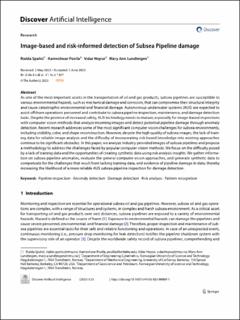| dc.contributor.author | Spahic, Rialda | |
| dc.contributor.author | Poolla, Kameshwar | |
| dc.contributor.author | Hepsø, Vidar | |
| dc.contributor.author | Lundteigen, Mary Ann | |
| dc.date.accessioned | 2023-11-06T08:50:12Z | |
| dc.date.available | 2023-11-06T08:50:12Z | |
| dc.date.created | 2023-06-12T16:01:24Z | |
| dc.date.issued | 2023 | |
| dc.identifier.citation | Discover Artificial Intelligence. 2023, 3 . | en_US |
| dc.identifier.issn | 2731-0809 | |
| dc.identifier.uri | https://hdl.handle.net/11250/3100692 | |
| dc.description.abstract | As one of the most important assets in the transportation of oil and gas products, subsea pipelines are susceptible to various environmental hazards, such as mechanical damage and corrosion, that can compromise their structural integrity and cause catastrophic environmental and financial damage. Autonomous underwater systems (AUS) are expected to assist offshore operations personnel and contribute to subsea pipeline inspection, maintenance, and damage detection tasks. Despite the promise of increased safety, AUS technology needs to mature, especially for image-based inspections with computer vision methods that analyze incoming images and detect potential pipeline damage through anomaly detection. Recent research addresses some of the most significant computer vision challenges for subsea environments, including visibility, color, and shape reconstruction. However, despite the high quality of subsea images, the lack of training data for reliable image analysis and the difficulty of incorporating risk-based knowledge into existing approaches continue to be significant obstacles. In this paper, we analyze industry-provided images of subsea pipelines and propose a methodology to address the challenges faced by popular computer vision methods. We focus on the difficulty posed by a lack of training data and the opportunities of creating synthetic data using risk analysis insights. We gather information on subsea pipeline anomalies, evaluate the general computer vision approaches, and generate synthetic data to compensate for the challenges that result from lacking training data, and evidence of pipeline damage in data, thereby increasing the likelihood of a more reliable AUS subsea pipeline inspection for damage detection. | en_US |
| dc.description.abstract | Image-based and risk-informed detection of Subsea Pipeline damage | en_US |
| dc.language.iso | eng | en_US |
| dc.publisher | Springer | en_US |
| dc.rights | Navngivelse 4.0 Internasjonal | * |
| dc.rights.uri | http://creativecommons.org/licenses/by/4.0/deed.no | * |
| dc.title | Image-based and risk-informed detection of Subsea Pipeline damage | en_US |
| dc.title.alternative | Image-based and risk-informed detection of Subsea Pipeline damage | en_US |
| dc.type | Peer reviewed | en_US |
| dc.type | Journal article | en_US |
| dc.description.version | publishedVersion | en_US |
| dc.source.pagenumber | 16 | en_US |
| dc.source.volume | 3 | en_US |
| dc.source.journal | Discover Artificial Intelligence | en_US |
| dc.identifier.doi | 10.1007/s44163-023-00069-1 | |
| dc.identifier.cristin | 2153896 | |
| cristin.ispublished | true | |
| cristin.fulltext | original | |
| cristin.qualitycode | 1 | |

